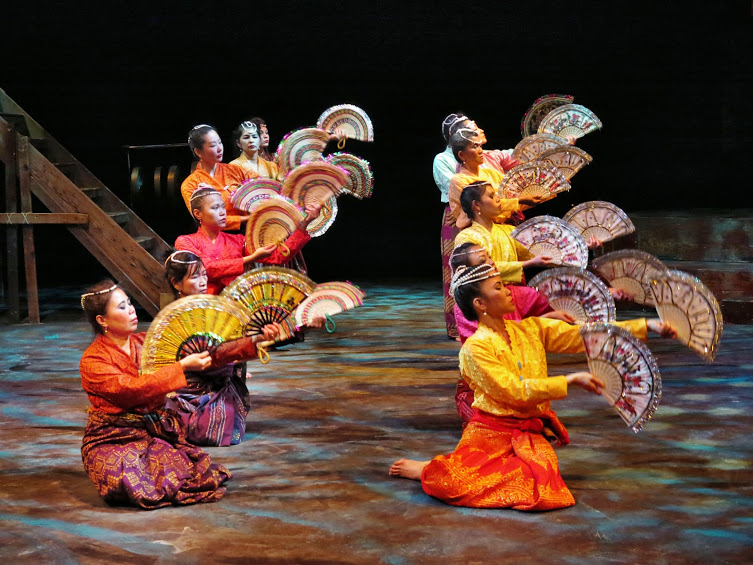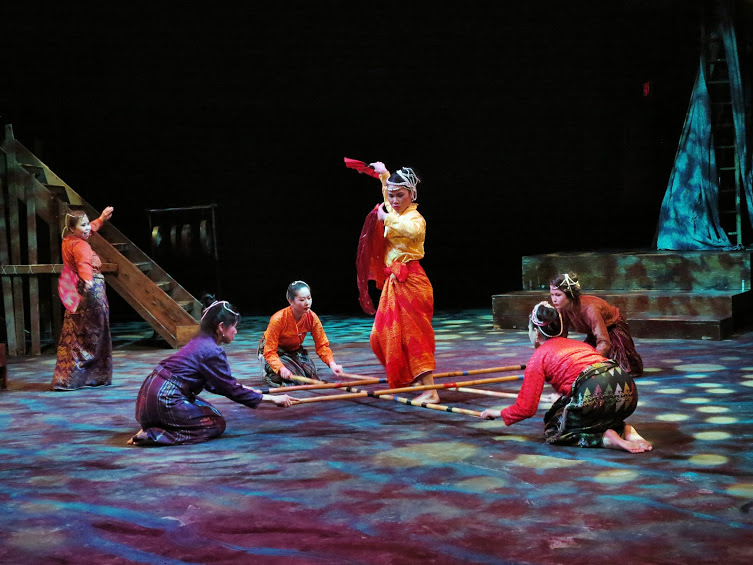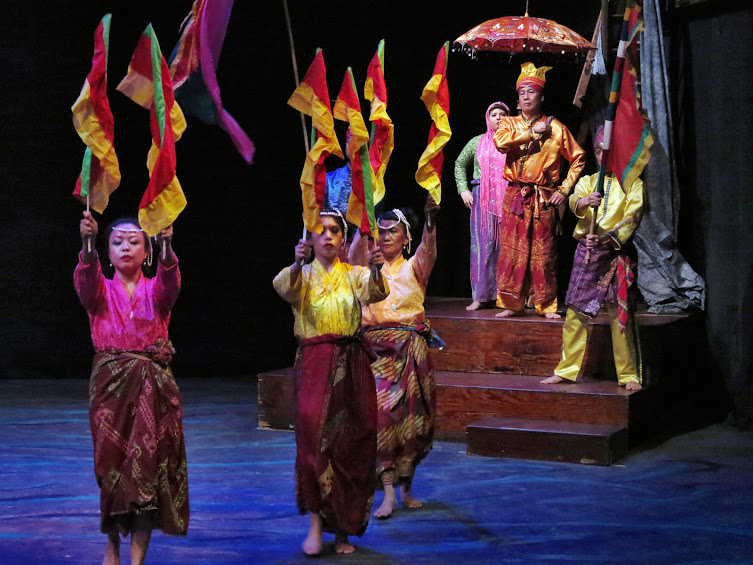Article By Pui See Tsang
Photo credit Jonathan Slaff
“Pagbabalik: Tracing the Path Home” by Kinding Sindaw, the New York-based Southern Philippine performance troupe, entwines a contemporary story of the modern Philippines with a dramatic adaptation of the third chapter of the epic Derangen. The Derangen is a Mindanao epic shared by the Maranao, Maguindanao and Iranun tribes of the southern Philippines, which celebrates episodes from regional history and stories of the tribulations of mythical heroes.
This splendorous new work of dance theater is conceived and directed by Potri Ranka Manis, the daughter of a Sultan of the Maranao people of Mindanao, a true modern-day princess and tradition-bearer. La MaMa E.T.C. presented the piece from April 24 to 27 in its Ellen Stewart Theatre on 366 East Fourth Street.
Contemporary Filipinos, both natives of the Republic and its expatriates, are familiar with the tug of war between the region’s verdant past and the forces of modernization, which are encroaching steadily on the land and its inhabitants. People have been widely displaced from ancestral lands by foreign corporations who manipulate local conflicts. In “Pagbabalik: Tracing the Path Home,” this process is expressed metaphorically by a Sorceress turning an old Sultan into stone in order to usurp his throne and install her adopted brother to become the new King. Their battle morphs into a mythical battle between the generous royal family of Bembaran and the sorceress Pirimbang of Dinalima o Rogong that is set out in the third chapter of the Maranao epic, the Darangen.
The Darangen Epic of the Maranao People was declared by UNESCO in 2005 to be a Masterpiece of the oral and Intangible Heritage of Humanity. For more information, see: http://www.unesco.org.
The dances of “Pagbabalik” are from the Maranao and Iranun tribes in Mindanao, each of whom has its own style of dance. While both copy the movements of nature, particularly the movements of water, Maranao dances reflect the serenity of the lake, with gentle waving and hand work, whereas Iranun dances convey the movements of the ocean with buoyant, up-and-down movements. Both forms use fans and scarves to enhance their storytelling, whose medium is the chant.
Instruments of musical accompaniment include the Kulintang (graduated brass gongs), Dabakan (drum), Sarunay (miniature Kulintang), Agong (gong), Babandir (Metronome), Gandingan (talking gongs), and Kubing (jaw harp). The Maranao dances are choreographed by Potri Ranka Manis and the Iranun dances are choreographed by Nodiah Biruar. Silat martial arts, with their graceful movements, are choreographed by Guro Frank Ortega. Silat is an ancient Malayu martial art form that is shared among Malaysia, Indonesia and the Philippines. In the Philippines, it is also known as Kali.
The wardrobes of the piece are authentic to the region, being woven by people from the tribes represented. Kinding Sindaw commissions them directly from the weavers in order to advocate for the continuity of the weaving and to inspire the craftspeople to continue in this art.
“Pagbabalik: Tracing the Path Home” is conceived, choreographed and directed by Potri Ranka Manis. The performers are Amira Aziza (dance captain #1/assistant choreographer), Nodiah Biruar, Diane Camino (dance captain #2), April Caravaca, George Circo, Shri Gleen Baun Cueto, Viktoria Danyiuk, Carmita Depasquale, Mohammed Zebede Dimaporo, Renia Gardner, Chelsea Kwon, Mark Malik Limasing, Monette Limasing, Potri Ranka Manis, Stephanie Mendez, Guro Frank Ortega, Lisa Parker (kulintang musician), Amira Rasoulpour, Tatiana Romero, Grace Asagra Stanley, Angela Torregoza, Rose Yapching (dance captain #3) and Kat Yew. The musicians are Lisa Parker, Amir Rasoulpour, Malaika Queano, Nur Nonilon Queano and Jonathan Lao. Lighting design is by Federico Restrepo. Sound design is by Tim Schellenbaum. Set design is by Mark Tambella.
Kinding Sindaw (Dance of Light), founded in 1992 by Potri Ranka Manis, is renowned for its majestic dance theater productions, which recreate the traditions of dance, music, martial arts, storytelling, and oratory of the indigenous peoples of the Philippines. Its repertoire is taken from the arts of the Iranun, T’boli, Maranao, Maguindanao, Yakan, Higaoonon, Tausug and Bagobo peoples of the southern Philippines. By asserting their arts and traditions, the historical and contemporary stories of these peoples are brought to life.
The Philippines, with over 7,100 islands, has a wide variety of genres of dance and music. This troupe specializes in a genre from the Sultanate of the Southern Philippines, with its ancestral dances, Kulintang music and Silat martial arts. In addition to La MaMa, the troupe has performed at the Museum of Natural History, Lincoln Center, Kennedy Center, the Smithsonian Institution, the World Trade Center, Theatre of the Riverside Church, the Alabama International Festival and various community and grassroots events.
The company’s La MaMa debut was “Rajah Mangandiri” (2000), an adaptation of The Ramayana, which was performed in a vibrant tapestry of royal court dances of the Sultanate, secular dances derived from animal movements, Silat martial arts, colorful silk costumes, kulintang music, gandingan the talking gongs, dabakan native drums, kubing bamboo jaw harp and haunting indigenous-chants from Maranao, Tiboli , Tausug and Maguindanao.
Jack Anderson (New York Times) wrote, “Kinding Sindaw created magic,” praising the “inventive adaptation,” which was conceived and choreographed by Potri Ranka Manis. Anderson reported that “theatrical wonders abounded” in the shipwreck and battle scenes and praising the “shimmering music by an ensemble of gongs and drums.” He added that, once acquainted with the story, children would enjoy the production as much as grown-ups and recommended “Rajah Mangandiri” as “fine wintertime entertainment for families who have overdosed on ‘The Nutcracker.'”
The company went on to five more major productions at La MaMa, each featuring a new synthesis of folklore, history and regional dances. “Lemlunay” (La MaMa, 2003) was a dramatic adaptation of a sacred epic myth of the same name from the T’boli people of Mindanao. “Parang Sabil” (2004) intertwined Tausug dance, music and storytelling with the recreation of the 1906 massacre of the Tausugs, an event of American imperialism that particularly outraged Mark Twain, whose texts were used in the production.
“Sultan Kudarat” (2005) was an account of a 17th century ruler who endured defeats by the Spaniards and rival sultans and eventually freed his people of Maguindanao (Flooded Plains) from Spanish domination. The ensemble for this production included four Maguindanao Master Artists who were descended from the Sultan.
“Bemberan” (2007) was, like the upcoming production, based on a chapter of “Derangen” and culminated in images of a historical event, the American-committed massacre in the Battle of Bayang in 1902. “Pandibulan: Bathing by Moonlight” (2010) was a dance work in which a woman from the southern Philippines, working as a caregiver in New York, rekindled her strength of spirit through the folklore and lifecycle rituals of the Yakan people of Basilan Island.
Artistic Director Potri Ranka Manis is Bai a Labi a Gaus of Borocot, Maguing, the 15th Pagawidan of Pat Pangempong ko Ranao. She was trained since childhood in the traditional dance, music and martial art forms of her people, and of other Philippine indigenous groups. As a child, she accompanied her father to gatherings with other tribes. At these festivities, she learned numerous social dances, mostly from other children.
She now lives and works in New York, carrying with her a rich wealth of cultural experience from traditions that are now facing extinction. Many of the cultures that spawned them are disappearing. She notes that throughout the Philippines, 95% of the population has been Latinized.
Only Mindainao retains its indigenous heritage (it was never colonized by the Spanish). Her choreography is developed partly from her own memories and partly from artists of the various tribes whose traditions are being enacted. All of Kinding Sindaw’s dances are created in collaboration with authentic members of the tribes they are drawn from.








Leave a Reply